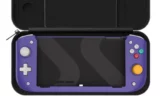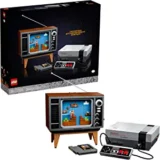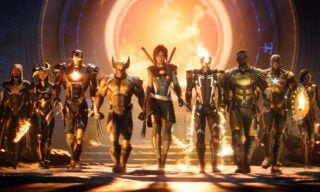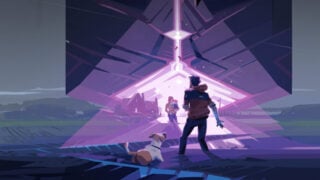Pokémon Scarlet and Violet are the most feature-rich entries in years
Game Freak has delivered what feels like the future of the series, although with some performance woes
- Director
- Shigeru Ohmori
- Key Credits
- Junichi Masuda (Exec Producer), Toby Fox (Composer)
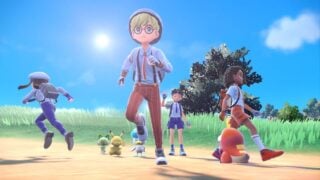
Pokémon is a series that rarely takes great leaps between generations. Being the largest media property in human history, it can frankly do what it wants, and as such, has never felt like a series that’s been desperate to be in lock-step with the rest of the industry.
It’s difficult to comprehend that after 26 years of games, Pokémon Scarlet and Violet mark the first that are truly open world, two decades after the genre dominated and saturated 3D games. And for some, simply making a classic Pokémon game in the traditional style would have been fine – and still sold comically well – but that’s not the case for Pokémon Scarlet and Violet. For the first time in an age, it feels like Game Freak is flexing its muscles in the main series.
Where Pokémon Sword and Shield felt like an attempt to simply get a Pokémon game out on the new hardware, and iterate later, Pokémon Scarlet and Violet deliver three games worth of ideas in one, with changes to a 25-year legacy that feel like a team taking onboard the often repeated idea that Pokémon doesn’t change to heart.
With a huge amount of content, a massive world to explore and an extremely exciting post-game (details of which we can’t mention), Pokemon Scarlet and Violet is bursting at the seams with ideas, even if it does feel like those ideas are a little ahead of the ageing platform that houses it.
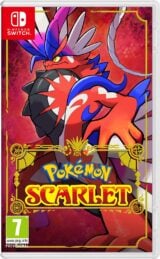
Instead of one main story quest that largely involves collecting 8 gym badges and facing the Elite 4, Pokémon Scarlet and Violet have 3 main story paths. One path is dedicated to the traditional Gym system, one has players chase down enormous titan Pokémon (similar to Pokémon Legends Arceus’ Noble Pokémon), and a third has you take on a horde of 30 Pokemon while running through an enemy base.
After an opening sequence establishing the world and a slightly too-long explanation of the world at large, you’re essentially let loose, free to pursue any of the three main questlines in any order you choose. There does seem to be a light guide as to which order you choose to do them in, mainly based on the level of the wild Pokémon in the area, but if you wanted to, and your team was good enough, you could do whatever you wanted right from the jump.
Victory Road, the path during which you take on eight gyms and then the elite four, is the most traditional of the various story modes. Each gym is type-specific, and thus are very easy to steam-roll should you have at least one Pokémon with a type advantage.
Pokemon Scarlet and Violet Guides:
Pokemon Scarlet and Violet walkthrough, tips, and Pokemon locations | Roaring Moon location | Iron Valiant location | Shiny sandwich recipes | Pokemon Scarlet and Violet Legendaries | Pokemon type chart
Returning from some of Pokémon Sword and Shield’s gyms are the gym challenges, small side quests that players have to complete in order to unlock the gym leader. These can be mini-games like rolling a giant Olive into a basket or talking to people around a town to solve a riddle. They’re enjoyable, and the cast of gym leaders is memorable, but as is usually the case, your time with them is all too brief.
The Path of Legends sees your character hunt a series of massive Pokémon that have been reportedly been spotted across the map. This usually involves entering a new part of the map and being contacted by a character to tell you you’re near the huge Pokémon, and that you should hunt them down.
These encounters are similar to the Noble Pokémon from Arceus. They’re enjoyable enough, but how these Pokémon feed into the overall story of the region is far more interesting. We’d have preferred for these hunts to be slightly more involved, as for more than one of the Titan Pokemon, we simply entered the area, and it was just standing in front of us, although one or two require some more effort.
“Pokemon Scarlet and Violet is bursting at the seams with ideas, even if it does feel like those ideas are a little ahead of the ageing platform that houses it.”
The third path sees the player clear out bases across the map that are run by Team Star, the game’s enemy team. Although “enemy team” is perhaps a bit strong, as outside of these events you rarely see the members out in the wild in the same numbers you’d see Team Rocket back in the day.
What makes these battles unique is that instead of normal Pokémon battles, players will send out three of their Pokémon to run around and automatically battle hordes of enemy Pokémon, with the aim of defeating 30 of them before time expires. This is an interesting twist on the formula, and it’s novel getting to run alongside your three strongest Pokémon, but they’re all very easy, and each follows a similar formula.
The advantage to having these three separate paths is that there always feels like something new to do to break up your experience. Want to explore the map? Go ahead, it’s entirely open from the start. Want to take down gyms? Go for it. Want to try your luck against much higher-level Pokémon trainers? You can find them out in the wild from the start.

It’s a very freeing experience. The Pokémon series has been guilty of hand-holding players far too much in the past and not allowing them to get into situations where they’re doomed to fail, but Pokémon Scarlet and Violet trust the player far more.
We were exploring an area around five hours into the game with a team of mid-20s level Pokémon, only to run into a level 75 Pokémon in a random side path of a cave. We were very quickly wiped out, but the idea that there were these hidden ultra-difficult encounters in the world gives exploring a sense of excitement and peril that has been missing from the main series games.
Battling itself gets an interesting new gimmick with Terastallizing, a new mechanic which allows Pokémon to assume a new, completely different additional type, meaning that a water type such as Quaxly could theoretically adopt the type advantages and disadvantages of a Fire-type, should it be found with that Tera-type.
“The Pokémon series has been guilty of hand-holding players far too much in the past and not allowing them to get into situations where they’re doomed to fail, but Pokémon Scarlet and Violet trust the player far more.”
This adds a new layer to battle, and the NPCs that you’ll face on your journey do a good job explaining how the new mechanic can add depth to battles. We hope this mechanic doesn’t go the way of Mega evolving, Z moves, or Dynamaxing, wherein it’s dropped after one generation.
Another break with tradition is how the game treats the game’s box legendary Pokémon, Miraidon or Koraidon. Firstly, you’re introduced to the Pokémon within the first hour, and are given it shortly after. However, there’s a twist: you can’t actually battle with the legendary Pokémon at first, as it’s been gravely wounded.
You can, however, use it as your mode of transport, as it becomes your bike, glider, dingy, and rock climbing apparatus. While this may, unfortunately, saddle Miraidon and Koraidon as the legendary Pokémon that are treated with the least difference, their place in the overall story makes them feel like a much bigger part of the game, rather than the tendency for box legendaries to essentially be a bit of post-game fluff you catch to round out your quest.

Their traversal powers are dolled out gradually, which also informs how the game suggests players explore the world. If it’s a place you can’t reach due to a lack of movement abilities, it’s probably home to Pokémon that will make mincemeat of your team.
However, as hinted at the start of this review, Scarlet and Violet feel too ambitious even for the Switch. Throughout our time with the games, we were truly disappointed by how they run on the Nintendo Switch hardware. Pokémon games have never been technical masterpieces, but the limited scope of the world in past games has done a lot to hide that.
To the games’ credit, there are very few loading screens, only really into the main central city, with the majority of the rest of the world traversable, and viewable from everywhere, but that’s also what makes the technical flaws so obvious.
The draw distance on not only the world, but the Pokémon that show up in the wild, is painfully short. The sense of scale in the world is lost when you see distant pieces of land flicker in and out of existence, entire towns disappear as you leave them. There are a lot of high vantage points across the region, and because of this, it makes for painful viewing when looking out across vistas of what appears to be unfinished land. Worse, however, is how this affects the Pokémon in the wild.
“We were truly disappointed by how they run on the Nintendo Switch hardware. Pokémon games have never been technical masterpieces, but the limited scope of the world in past games has done a lot to hide that.”
Pokémon being visible in the overworld feels like a change that must be set in stone going forward with the series. It adds to the emersion, makes the Pokémon feel part of the habitat, and makes hunting for them so much more exciting. However, in Pokémon Scarlet and Violet, standing even a short distance from the Pokémon will cause their models to revert to a low-poly version, meaning round Pokemon are suddenly jagged octagons, and the Pokemon’s textures fall away to mush.
Plenty of games use low-poly models when the player is far away to save on rendering something you can’t see, but in this game, it’s so noticeable that it breaks the emersion. You can literally go into any open field and walk back and forth to find the exact distance the game spawns in the proper models.
The game’s framerate is also extremely inconsistent, with some battles becoming more like slideshows, and certain open-world areas making the game feel like it’s about to crash. Much like the low-res Pokémon issue, there’s also a distance where the Pokémon stop animating at their full framerate, meaning Pokémon that flap their wings look like malfunctioning robots when you get some distance from them.


The entire fantasy of Pokémon is that these are real creatures that live in this world alongside humans, and while the actual cast of new and returning Pokémon is an excellent mix, and our favourite new class of Pokémon since Ruby and Sapphire, these technical issues let the fantasy down.
Pokémon Scarlet and Violet get so much completely right from a gameplay and story perspective. However, the technical aspects of the game need that same love, especially as the series presumably moves to the next hardware by the time of the next new generation.
Pokémon Scarlet and Violet feel like a proof of concept of the future of Pokémon. The series, now not far from 30 years of dominance, can’t really go back to the quaint tiny towns and limited encounters of the past.
Every decision Scarlet and Violet make are good ones. The huge expansion and changes to the single player campaign are great, the size of the world and the joy of exploration are the best in the series, and the new Pokemon and battle mechanics introduced all sing. However, it’s just impossible to shake the thought of how much better the game would feel if it was on more powerful hardware, or simply ran acceptably on Switch.
- Great new Pokemon
- Three story paths are a fantastic change
- The open-world hunt for Pokemon is engaging
- Exciting post-game
- Terrible performance















